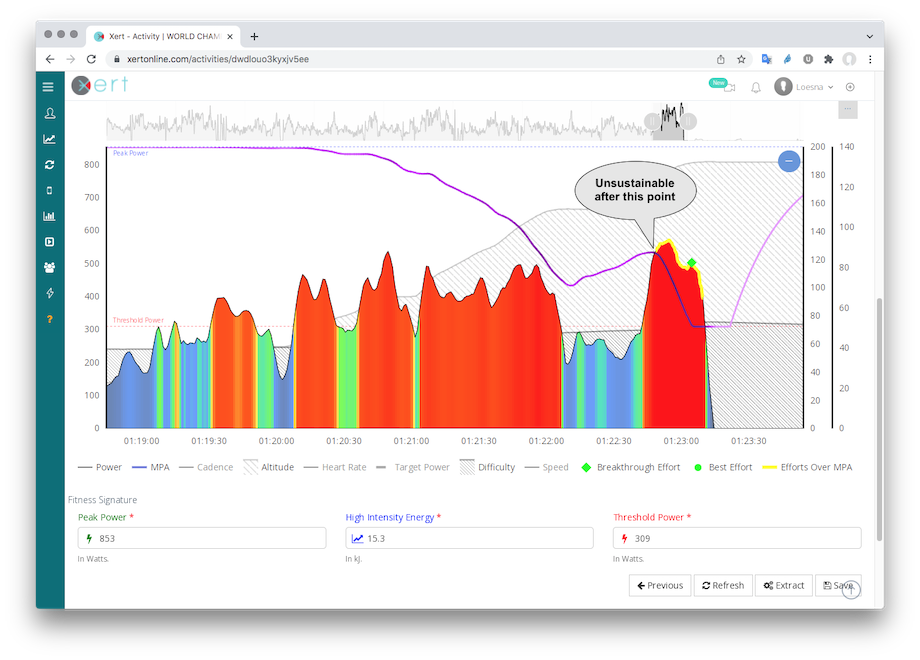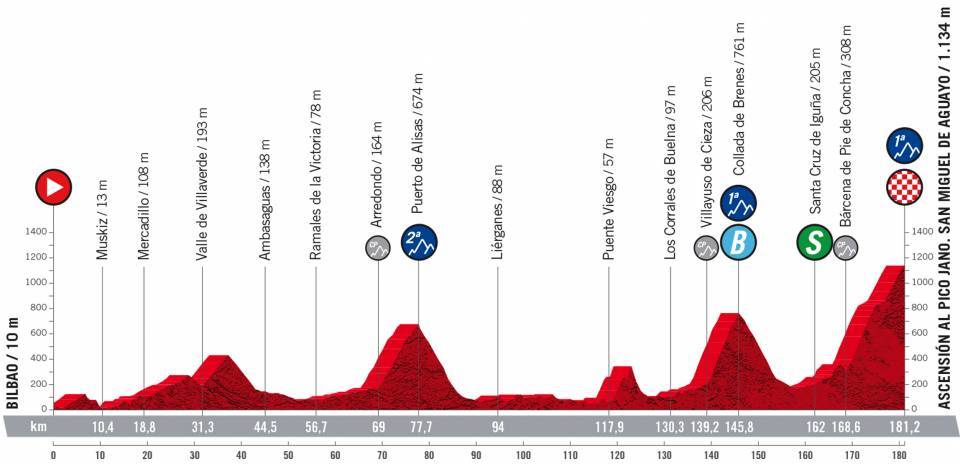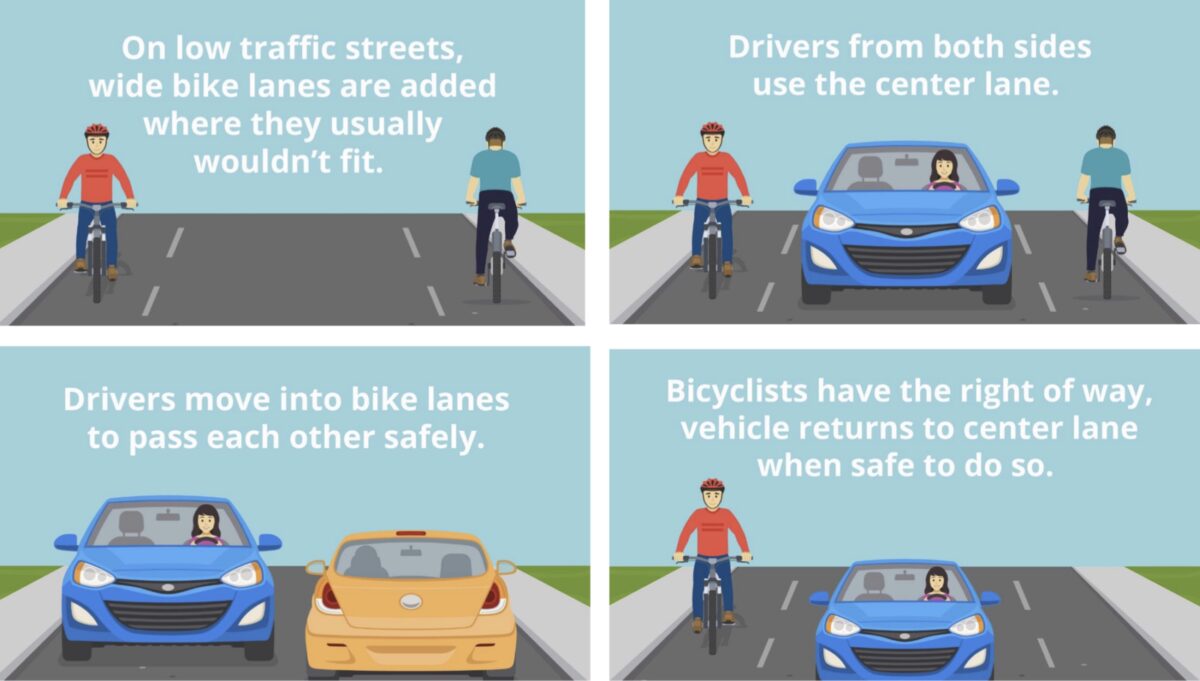
On February 26th, 2022, athletes from around the world competed in the UCI eSports World Championships. How did Loes Adegeest train specifically for the Worlds to ride into the rainbow jersey?
Loes Adegeest from the Netherlands won the 2022 UCI Zwift World Champs with a perfectly executed race and final surge up NYC. She’s used Xert for the past 6 months to train specifically for the race, so we’ve had a chance to dissect her buildup and race itself.
We’ve previously written specific articles on Xert’s Maximal Power Available metric; its Fitness Signature dimensions of Peak Power, High Intensity Energy, and Threshold Power; and how I’ve used Xert in my own training.
Full disclosure, I’m the Chief Sport Scientist for Xert and Baron Biosystems.
 This year’s race was two and a half laps of the NYC Knickerbocker circuit with the finish line atop the NYC KOM. The circuit is relatively flat aside from the NYC KOM climb giving the entire race nearly 1000m of elevation gain over the 57km. It’s a tough finish with a middle 500m section at 10.6% for 400m and then 100m at 15.7%. The final 500m of the race features a flat 300m followed by 100m climb at 10.8% and a flat 100m to the finish.
This year’s race was two and a half laps of the NYC Knickerbocker circuit with the finish line atop the NYC KOM. The circuit is relatively flat aside from the NYC KOM climb giving the entire race nearly 1000m of elevation gain over the 57km. It’s a tough finish with a middle 500m section at 10.6% for 400m and then 100m at 15.7%. The final 500m of the race features a flat 300m followed by 100m climb at 10.8% and a flat 100m to the finish.
To see the story of the race, we can look at her power and elevation data and as well as her Maximum Power Available (MPA). MPA is Xert’s unique metric the depicts how much power an athlete has any given moment in a race. It is the purple line on the chart above and is an indicator of fatigue. The value goes further than just showing fatigue as it also depicts how this fatigue is affecting an athlete’s ability to produce power – their maximum power.

As you can see, Loes’ MPA sees some relatively minor dips during the first two climbs. Her power data is mostly blue (low intensity) with only short yellow and red efforts during the NYC KOM climbs on each lap. She had conserved energy very effectively, never being pushed or tested at any point in the race.
On the final lap, a few women remained, including defending champion, Ashleigh Moolman-Pasio. Team USA launched attack after attack with Katheryn Curi making a strong move leading into the final NYC KOM climb. She was caught passed by “AMP” and three women managed to bridge and hang on: Cecilia Hansen, Zoe Langham and Loes Adegeest.
 Here’s a closeup of the final climb to the line. Loes gets the hallmark power and MPA representation of a win – a breakthrough-on-the-line. This happens when an athlete reaches and sustains a breakthrough effort as they cross the finish line. It’s the definition of a perfect ending to a race.
Here’s a closeup of the final climb to the line. Loes gets the hallmark power and MPA representation of a win – a breakthrough-on-the-line. This happens when an athlete reaches and sustains a breakthrough effort as they cross the finish line. It’s the definition of a perfect ending to a race.
Loes played the final climb really smartly. She took a moment on the flat second section before the final pitch to the finish to recover just slightly, and at the base of the final sharp pitch she deployed her feather power-up and at the same time as launching an all-out maximal effort with everything she had for 20s. The power-up and effort were perfectly timed, something she had practiced over and over with breakthrough after breakthrough efforts in her training.
It’s NOT All About FTP
Let’s take a closer look at Loes’s Xert fitness signature and how it matches our traditional obsession with Threshold Power (TP). We’ll see that, while a high TP is almost never a bad thing, there’s a ceiling that we often hit and that bigger gains can come from focusing on High Intensity Energy (HIE).

The system evaluated her signature on this day to be 853W, 19.3kJ and 309W for her Peak Power (PP), High Intensity Energy and Threshold Power, respectively. A TP of 309W at just 57kg is an impressive 5.4W/kg. But it wasn’t just her Threshold Power that made this win happen. It was her HIE too.
In the weeks leading into the Worlds, after a build phase focused on raising her TP, Loes’s HIE was as low as 15.3kJ. What if she had continued to focus on her Threshold Power and not on her High Intensity Energy? What would it have taken to achieve the same result? To find out, we use the Advanced capabilities of Xert to examine how another athlete’s signature fits the same power data by modeling different combinations of PP, HIE, and TP.

Here we model Loes if she kept her TP at her actual value of 309 W, but if she hadn’t built up her HIE and it remained at 15.3 kJ. We see that MPA drops below Loes’s actual power output, meaning that what she did on race day would have been impossible if her HIE stayed at 15.3 kJ with her TP at 309 W.

Here we have an athlete with a low High Intensity Energy of 15kJ. In order to perform the same effort Loes performed that day, this athlete would have needed to have a Threshold Power of 327W! (5.7W/kg!)
For female cyclists, this level of TP would be reserved for a very, very few at the top of their game. Had Loes been focused on her Threshold Power, reaching 327W would have been highly improbable, perhaps even impossible given her time window of 8 weeks from qualification in December to race day.
Others may have examined race details and thought that focusing on sprint power would be a good way to prepare. The final effort is only 20s so could be for sprinters? What if her Peak Power had risen to 1000W?
 Doesn’t seem like it would have helped much at all. Threshold Power would still need to be in rarified territory (324W). That final 20s effort isn’t performed in a relatively rested state, hence Peak Power doesn’t have a lot of influence on the athlete’s ability to push this power under this much fatigue. Pure sprinters really don’t have a chance here.
Doesn’t seem like it would have helped much at all. Threshold Power would still need to be in rarified territory (324W). That final 20s effort isn’t performed in a relatively rested state, hence Peak Power doesn’t have a lot of influence on the athlete’s ability to push this power under this much fatigue. Pure sprinters really don’t have a chance here.
Learning from a World Champ
What are the big takeaways for me from analyzing Loes’s winning ride?
- Threshold Power is great, but racing often requires ramping up High Intensity Energy. This is in line with the general themes of periodization, where the Base and early Build phases are generally devoted to building aerobic capacity and threshold power. But in the later Build and into the Peak phase, that’s the time to sharpen up race fitness and the capacity to repeatedly surge and dig deep. We saw this with Loes, where she came into the final peak phase with a highly developed TP but a relatively low HIE, then focused her final weeks on workouts focused on building up HIE.
- Race specificity is key. Especially in online racing, you can recon the course as many times as you wish. This allows you to tailor your workouts specifically to the demands of the event. In Loes’s case, she did multiple workouts and efforts on the final NYC climb, so she knew exactly how to customize her training, gearing choice, pacing, etc.
- Racing is not steady state! We may easily get lulled into thinking that a race-defining effort “lasts” 4 min, so therefore the best way to train is to do intervals at your 4 min maximal power. However, as we see on the NYC climb, Loes hit a range of wattages, with the final surge at a much higher wattage AND UNDER FATIGUE. That final surge therefore is much harder than just riding at her 4 min maximal power from a fresh and non-fatigued state. So training for it doesn’t involve just repeatedly doing max 4 min efforts. Instead, your Peak phase training should aim to incorporate efforts that require you to hit efforts at a variety of supra-threshold wattages AND from a state of fatigue. Not easy but there just might be a rainbow waiting at the end!

Here’s Loes’s training progression in the final 2+ months leading up to the Worlds. You see a huge build with a team training camp followed by a classic taper featuring a huge reduction in volume but still lots of intensity.
Check out Xert for a free 30-day trial.
Ride fast and have fun!











